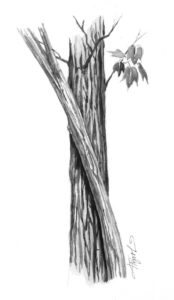By Susan Shea
Beneath the forest canopy, or overstory, of towering trees is a second layer of vegetation known as the understory. It is composed of shrubs, saplings, and understory trees that grow in the dappled shade of the overstory. One understory specialist is striped maple, a small tree that seldom grows more than 20 feet high and 8 inches in circumference. Despite its moderate stature, striped maple plays an important ecological role in the forest, providing shelter and food for a variety of wildlife.

Striped maple trees (Acer pensylvanicum) are easy to identify in all seasons by their greenish bark with vertical white stripes or black mottling, and their smooth, green twigs. The red winter buds and large terminal bud (nearly inch long) are also good identification characteristics. These buds grow even larger as they swell during spring. The leaves that unfurl after bud burst are big, three-lobed, and finely toothed. At 5 to 6 inches long and almost as wide, striped maple leaves are the largest of the Northeast’s native maples. Because of the leaf shape, this tree is also known as goosefoot. Other names for it include moosewood and moose maple, since moose consume the trees’ buds, leaves, and bark. Striped maple is sometimes confused with mountain maple, another common understory tree which has smaller, coarsely-toothed leaves and brownish bark.
Drooping strings of yellow-green, bell-shaped flowers emerge on striped maple about the same time the leaves unfold. These flowers develop into clusters of samaras-the paired, winged seeds produced by all maple species -which ripen in fall and disperse on late autumn winds. A striped maple tree may produce only female flowers, only male flowers, or both sexes in one year. Some striped maples have even been found to switch sex from year to year in response to stressors such as injuries and changing environmental conditions.
Widely distributed across the northeastern United States and southeastern Canada, striped maple grows as far west as Minnesota and Ontario and south in the Appalachians to Georgia. It prefers well-drained, acidic soils on cool, upland sites in northern hardwood, conifer, and mixed forests. In our region, striped maple grows best at elevations between 1,800 feet and 2,600 feet. Protected from wind by the overstory, this maple does not need deep roots, and its roots tend to be shallow and wide-spreading. It is well-adapted to survive in the deep shade of the understory, but grows very slowly unless a nearby tree falls or the forest is thinned, allowing more sunlight to penetrate the canopy. Striped maples over 100 years old have been found in forest openings.
Striped maple and other understory plants help create vertical diversity in a forest. Multiple layers of vegetation provide a greater variety of food and microhabitats for insects and other animals, enhancing the overall biodiversity of the forest. Vegetation layers are especially important for birds, as different species prefer to forage and nest at different heights. The black-throated blue warbler, for instance, often nests in understory shrubs or small trees such as striped maple.
Some Native American people traditionally used the wood of the striped maple for arrows and the bark to make a beverage and for medicinal purposes. Colonial farmers fed striped maple leaves to their horses and cattle and allowed their livestock into the woods to browse on the tree’s spring shoots.
In addition to its ecological value as an understory tree, striped maple is an important food source for a variety of wildlife. Honeybees feed on nectar from striped maple flowers. Moose, deer, and snowshoe hare browse twigs and buds during winter and moose eat the leaves in summer. I have often seen striped maples in the Green Mountains with rows of long, vertical grooves on their trunks, where moose scraped off the bark in early spring, using an upward motion of their lower incisors, likely to obtain minerals from the sap. Porcupines and beaver consume the bark. Ruffed grouse eat the buds, and grouse, squirrels, and chipmunks feast on the seeds.
The next time you take a walk in the forest, keep your eyes open for this often-overlooked, but valuable understory tree.
Susan Shea is a naturalist, writer, and conservationist based in Vermont. Illustration by Adelaide Murphy Tyrol. The Outside Story is assigned and edited by Northern Woodlands magazine and sponsored by the Wellborn Ecology Fund of the New Hampshire Charitable Foundation: nhcf.org.




